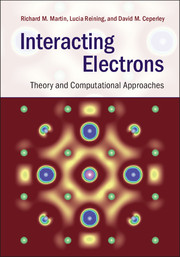Book contents
- Frontmatter
- Dedication
- Contents
- Preface
- Acknowledgments
- Notation
- Part I Interacting electrons: beyond the independent-particle picture
- Part II Foundations of theory for many-body systems
- Part III Many-body Green's function methods
- 9 Many-body perturbation theory: expansion in the interaction
- 10 Many-body perturbation theory via functional derivatives
- 11 The RPA and the GW approximation for the self-energy
- 12 GWA calculations in practice
- 13 GWA calculations: illustrative results
- 14 RPA and beyond: the Bethe–Salpeter equation
- 15 Beyond the GW approximation
- 16 Dynamical mean-field theory
- 17 Beyond the single-site approximation in DMFT
- 18 Solvers for embedded systems
- 19 Characteristic hamiltonians for solids with d and f states
- 20 Examples of calculations for solids with d and f states
- 21 Combining Green's functions approaches: an outlook
- Part IV Stochastic methods
- Part V Appendices
- References
- Index
12 - GWA calculations in practice
from Part III - Many-body Green's function methods
Published online by Cambridge University Press: 05 June 2016
- Frontmatter
- Dedication
- Contents
- Preface
- Acknowledgments
- Notation
- Part I Interacting electrons: beyond the independent-particle picture
- Part II Foundations of theory for many-body systems
- Part III Many-body Green's function methods
- 9 Many-body perturbation theory: expansion in the interaction
- 10 Many-body perturbation theory via functional derivatives
- 11 The RPA and the GW approximation for the self-energy
- 12 GWA calculations in practice
- 13 GWA calculations: illustrative results
- 14 RPA and beyond: the Bethe–Salpeter equation
- 15 Beyond the GW approximation
- 16 Dynamical mean-field theory
- 17 Beyond the single-site approximation in DMFT
- 18 Solvers for embedded systems
- 19 Characteristic hamiltonians for solids with d and f states
- 20 Examples of calculations for solids with d and f states
- 21 Combining Green's functions approaches: an outlook
- Part IV Stochastic methods
- Part V Appendices
- References
- Index
Summary
An idea that is developed and put into action is more important than an idea that exists only as an idea.
BuddhaSummary
In this chapter we sketch how GW calculations are performed in practice, touching upon approximations and numerical methods. Typical calculations are done in three steps: one has to determine the dynamically screened Coulomb interaction W, build the GW self-energy, and finally solve the quasi-particle or Dyson equation. All steps have their own difficulties. Choices have to be made, and the calculations are challenging for many materials. Computational approaches are constantly evolving, but many of the aspects contained in the chapter are expected to remain topical for quite some time.
GW calculations have become part of the standard toolbox in computational condensedmatter physics. Many details on foundations and putting into practice can be found in overviews and reviews, like [287, 334, 347, 408].
What does it mean to do a GWA calculation in practice? The formula for the GWA self-energy is as simple as its name, but GW calculations have a long history with continuous improvements. Modern GWA calculations are in the continuation of pioneering attempts to include correlations beyond Hartree–Fock using the concept of screening. Already in 1958 [409] correlation energies for the homogeneous electron gas were obtained from the study of the polarization of the gas due to an individual electron, and from the action of this polarization back on the electron, through the self-energy. These calculations, including several approximations, were limited to states close to the Fermi level. A GWA-like approach [410, 411] was applied to the electron gas in 1959, although these calculations didn't cover the range of densities rs ~ 2 - 5 which is typical for simple metals. Hedin's work [43] is fundamental in that it presented the GWA as the first term of a series in terms of the screened Coulomb interaction, and it contained an extensive description of the homogeneous electron gas on the GWA level. Many more studies on the HEG followed, including detailed investigation of the spectral functions [383, 384, 412], the importance of self-consistency [351, 352, 392], the electron gas in lower dimensions [369] (see also Ch. 11), and vertex corrections beyond the GWA (e.g., [413–415]), as discussed in Ch. 15.
- Type
- Chapter
- Information
- Interacting ElectronsTheory and Computational Approaches, pp. 280 - 310Publisher: Cambridge University PressPrint publication year: 2016



